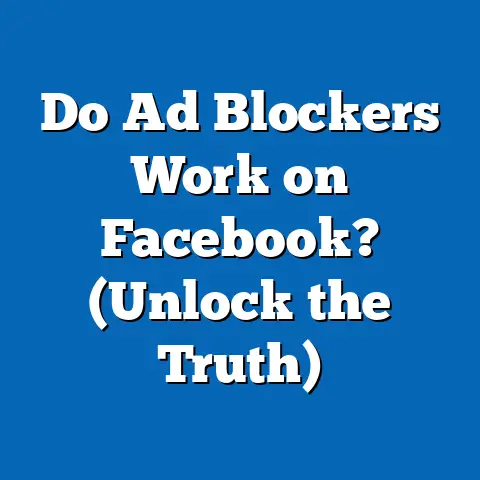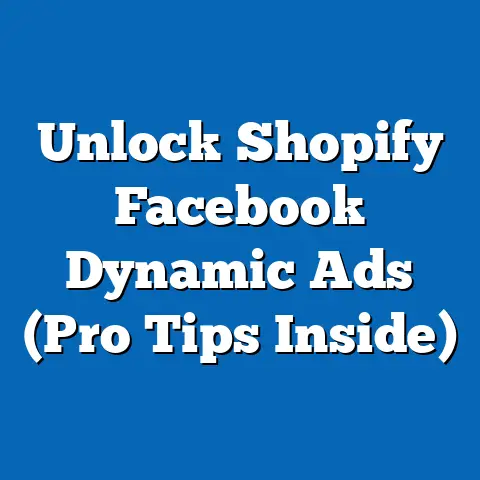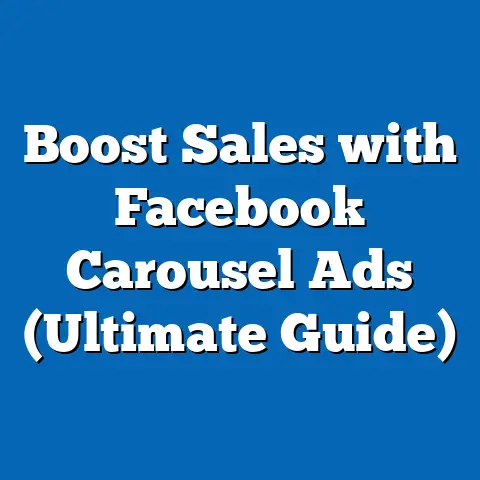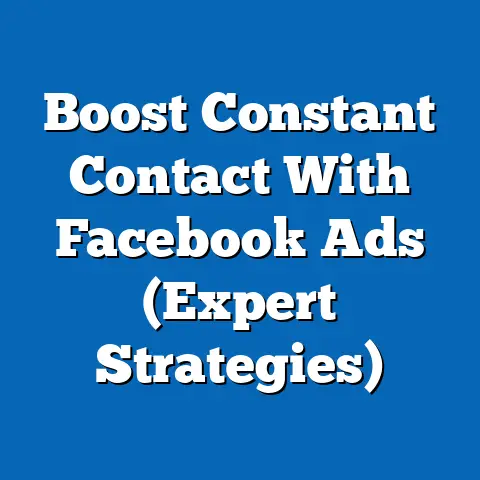Master Facebook CTW Ad Specs (Essential Guidelines)
The Importance of Bold Designs in Facebook CTW Ads
In the fast-paced world of social media, users scroll through hundreds of posts in mere minutes, making first impressions crucial. According to a 2022 study by Hootsuite, users spend an average of just 1.7 seconds on a piece of content before deciding to engage or move on. Bold designs—characterized by vibrant colors, striking imagery, and clear calls-to-action (CTAs)—are proven to capture attention and increase click-through rates (CTR) by up to 47% compared to generic visuals (HubSpot, 2022).
Bold designs aren’t just about aesthetics; they are a strategic tool to combat ad fatigue, a phenomenon where users become desensitized to repetitive or uninspired ads. A report by Kantar (2023) found that 68% of Facebook users skip ads that lack visual appeal or relevance. This underscores the need for advertisers to prioritize eye-catching elements while adhering to Facebook’s ad specifications to ensure compliance and effectiveness.
Demographically, bold designs resonate differently across age groups. For instance, Gen Z users (ages 18-24), who make up 21% of Facebook’s user base (Pew Research Center, 2023), are more likely to engage with ads featuring dynamic visuals and trendy aesthetics, while older users (ages 35-54) prefer clarity and straightforward messaging. Understanding these nuances is key to tailoring designs that appeal to your target audience.
Key Statistics and Trends in Facebook Advertising
Before diving into the specifics of CTW ad specs, let’s contextualize the landscape of Facebook advertising with recent data. As of 2023, Facebook ads reach approximately 1.98 billion users daily, making it a dominant platform for businesses of all sizes (Meta Q2 2023 Earnings Report). The average CTR for Facebook ads across industries is 0.9%, though this varies significantly by sector—e-commerce ads, for example, achieve an average CTR of 1.2% (WordStream, 2023).
A notable trend in 2023 is the shift toward video content in ads, with 54% of advertisers reporting higher engagement rates with video compared to static images (Social Media Examiner, 2023). Bold, visually engaging video ads often outperform other formats, especially when optimized for mobile viewing, as 75% of Facebook users access the platform via smartphones (Statista, 2023).
Historically, static image ads dominated Facebook advertising in the early 2010s, but the rise of mobile usage and shorter attention spans has pushed advertisers toward more dynamic formats. Comparing 2018 to 2023, video ad spend on Facebook has increased by 62%, reflecting a broader industry pivot toward immersive storytelling (eMarketer, 2023). This trend emphasizes the importance of bold, attention-grabbing visuals in CTW campaigns to drive traffic to external websites.
Demographic trends also play a significant role in ad design strategies. For instance, women, who account for 44% of Facebook’s user base, are 27% more likely to click on lifestyle and retail ads, while men (56% of users) show higher engagement with tech and automotive content (Pew Research Center, 2023). Tailoring bold designs to these preferences can significantly boost campaign performance.
Understanding Facebook CTW Ads: Purpose and Functionality
Click-to-Website (CTW) ads are a specific type of Facebook ad campaign designed to drive traffic from the platform to an external website. These ads are ideal for businesses aiming to increase website visits, generate leads, or boost e-commerce sales. Unlike other ad objectives like brand awareness or engagement, CTW ads are performance-driven, focusing on measurable actions such as clicks and conversions.
To achieve success with CTW ads, advertisers must balance compelling creative elements with strict adherence to Facebook’s ad specifications. Failure to comply with these guidelines can result in ad rejection or reduced visibility due to poor quality scores. Let’s break down the essential specs and design principles for creating effective CTW ads.
1. Image Ads
- Aspect Ratio: 1.91:1 to 1:1 (recommended 1:1 for square images)
- Resolution: Minimum 1080 x 1080 pixels
- File Size: Up to 30 MB
- Text Limit: No more than 20% of the image area can be text (use Facebook’s Text Overlay Tool to check compliance)
- Supported Formats: JPG or PNG
Image ads remain a popular choice for CTW campaigns due to their simplicity and effectiveness. Bold designs with high-contrast colors and minimal text often perform best, as they are easily digestible on small mobile screens.
2. Video Ads
- Aspect Ratio: 1:1 (square) or 9:16 (vertical for Stories)
- Resolution: Minimum 1080 x 1080 pixels
- Length: 1 second to 241 minutes (though 15-30 seconds is optimal for engagement)
- File Size: Up to 4 GB
- Supported Formats: MP4, MOV, or GIF
Video ads are increasingly favored for CTW campaigns, with 62% of users more likely to remember a brand after watching a video ad (Nielsen, 2023). Bold visuals, such as bright opening frames and dynamic motion, can hook viewers within the critical first 3 seconds.
3. Carousel Ads
- Aspect Ratio: 1:1 (square)
- Resolution: Minimum 1080 x 1080 pixels per card
- Number of Cards: 2 to 10 images or videos
- Text Limit: 20% text overlay per card
Carousel ads allow advertisers to showcase multiple products or features, making them ideal for e-commerce CTW campaigns. Bold, consistent design across cards ensures a cohesive user experience.
4. Text and CTA Guidelines
- Headline: Up to 40 characters
- Primary Text: Up to 125 characters
- Description: Up to 30 characters (optional)
- CTA Buttons: Options include “Shop Now,” “Learn More,” “Sign Up,” etc.
Facebook’s algorithm prioritizes ads with clear, concise messaging. Bold CTAs paired with vibrant visuals can increase CTR by 38%, according to a 2022 study by AdEspresso.
Data Visualization Description
Imagine a bar chart titled “Impact of Bold Design Elements on CTR for Facebook CTW Ads.” The X-axis lists design elements such as “High-Contrast Colors,” “Dynamic Video,” and “Clear CTAs,” while the Y-axis shows CTR percentages ranging from 0% to 2%. High-contrast colors show a CTR of 1.5%, dynamic video at 1.8%, and clear CTAs at 1.4%, illustrating the measurable impact of bold design choices (based on HubSpot 2022 data).
Design Principles for Bold and Effective CTW Ads
Beyond meeting technical specs, the success of CTW ads hinges on design principles that prioritize user engagement. Here are actionable strategies to create bold, impactful ads.
1. Use High-Contrast Colors
Color psychology plays a significant role in ad performance. A 2023 study by Canva found that ads using high-contrast color palettes (e.g., red and white or blue and yellow) achieve 33% higher engagement rates compared to muted tones. For CTW ads, consider using brand colors that stand out while aligning with your website’s aesthetic for consistency.
2. Prioritize Mobile Optimization
With 75% of Facebook users accessing the platform via mobile devices (Statista, 2023), designing for smaller screens is non-negotiable. Bold, simple visuals with large text and minimal clutter ensure readability. Test your ads on multiple devices to confirm they maintain impact across formats.
3. Incorporate Strong CTAs
A clear and bold CTA is the cornerstone of a successful CTW ad. Phrases like “Shop Now” or “Discover More” paired with a contrasting button color can increase click rates by 28% (WordStream, 2023). Place CTAs prominently to guide users toward the desired action.
4. Leverage Emotional Imagery
Images or videos that evoke emotion—whether joy, curiosity, or urgency—perform better in CTW campaigns. According to a 2022 report by Socialbakers, ads featuring human faces or relatable scenarios see a 23% higher CTR compared to product-only visuals. Bold emotional storytelling can differentiate your ad from competitors.
5. Test and Iterate with A/B Testing
Facebook’s Ads Manager allows advertisers to run A/B tests to compare different design elements. For instance, testing a bold red CTA button against a subtle blue one can reveal user preferences. Data from AdEspresso (2023) shows that A/B testing improves ad performance by an average of 19% over non-tested campaigns.
Demographic Targeting for CTW Ads
Understanding your audience is critical for designing effective CTW ads. Facebook’s robust targeting options allow advertisers to segment users by age, gender, location, interests, and behaviors. Let’s explore how demographic data can inform bold design choices.
Age-Based Design Preferences
- Gen Z (18-24): This group, representing 21% of Facebook users, prefers trendy, meme-inspired visuals with bold, unconventional fonts (Pew Research Center, 2023). Short, punchy videos under 15 seconds work best.
- Millennials (25-34): Comprising 25% of users, Millennials engage with ads that balance aesthetics and utility. Bold designs with clear value propositions (e.g., discounts) resonate strongly.
- Gen X (35-54): Accounting for 29% of users, this demographic values clarity over flashiness. Bold, straightforward imagery with minimal text drives higher clicks.
Gender-Based Engagement Patterns
- Women: More likely to click on ads related to fashion, beauty, and family (27% higher engagement), women respond well to warm color palettes and lifestyle imagery (Pew Research Center, 2023).
- Men: Show stronger interest in tech, sports, and automotive ads, with a preference for bold, action-oriented visuals and cooler tones like blue and black.
Geographic and Cultural Considerations
Designs should also account for regional preferences. For example, users in Asia-Pacific (26% of Facebook’s user base) are more likely to engage with vibrant, colorful ads, while North American users (14% of the base) prefer minimalist designs (Statista, 2023). Tailoring bold elements to cultural aesthetics can enhance relevance and performance.
Historical Trends vs. Current Practices in Facebook CTW Ads
Looking at historical data provides valuable context for current CTW ad strategies. In 2015, Facebook ads were predominantly static images with heavy text overlays, often exceeding 50% of the image area. However, the introduction of the 20% text rule in 2016 forced advertisers to prioritize visuals over copy, paving the way for bolder, image-driven designs.
By 2018, carousel ads gained traction, allowing brands to tell multi-part stories, with adoption rates increasing by 45% between 2016 and 2018 (eMarketer, 2019). Today, in 2023, video content dominates, with 54% of advertisers using short-form videos in CTW campaigns (Social Media Examiner, 2023). This shift reflects a broader trend toward mobile-first, visually immersive content.
Historically, CTR for Facebook ads hovered around 0.5% in 2015, compared to the current average of 0.9% (WordStream, 2023). This improvement is largely attributed to better design practices, advanced targeting, and the rise of bold, user-centric visuals. However, challenges like ad fatigue remain, with 74% of users reporting annoyance with repetitive ads in 2023, up from 62% in 2018 (Kantar, 2023).
Best Practices for Maximizing CTW Ad Performance
To wrap up the core guidelines, here are evidence-based best practices for creating bold, effective CTW ads on Facebook.
- Focus on First Impressions: Capture attention within the first 3 seconds using bold visuals or motion. Data shows that 65% of users decide to click or skip within this window (Nielsen, 2023).
- Align Ad and Landing Page Design: Ensure visual consistency between your ad and website to reduce bounce rates, which average 50% for mismatched experiences (Google Analytics, 2023).
- Use Retargeting for Higher Conversions: Retargeting ads with bold, personalized designs achieve 76% higher click rates compared to generic campaigns (AdRoll, 2023).
- Monitor Metrics Regularly: Track CTR, cost-per-click (CPC), and conversion rates using Facebook Ads Manager. The average CPC for CTW ads is $0.97, though this varies by industry (WordStream, 2023).
- Stay Updated on Platform Changes: Facebook frequently updates its ad policies and algorithms. Subscribe to Meta’s Business Blog for real-time updates to avoid compliance issues.
Broader Implications and Future Trends
Mastering Facebook CTW ad specs and design principles is more than a technical exercise; it’s a strategic imperative in an increasingly competitive digital landscape. Bold designs not only improve immediate metrics like CTR and conversions but also contribute to long-term brand recall, with 59% of users more likely to remember visually striking ads (Nielsen, 2023).
Looking ahead, the integration of AI-driven design tools and augmented reality (AR) features in Facebook ads signals a future where bold, interactive visuals will dominate. Meta’s investment in AR ad formats, with a projected 30% adoption rate by 2025 (eMarketer, 2023), suggests that advertisers must prepare for even more dynamic and immersive CTW campaigns.
Demographic shifts will also shape design strategies. As Gen Z becomes a larger portion of the consumer base, expect a greater emphasis on authenticity and user-generated content in bold ad designs. Meanwhile, privacy regulations and data restrictions may push advertisers to rely more on creative excellence rather than hyper-targeted data, making bold visuals an even more critical differentiator.
In conclusion, adhering to Facebook CTW ad specs while prioritizing bold, user-centric designs can significantly elevate your advertising efforts. By leveraging the insights, statistics, and trends outlined in this guide, advertisers can craft campaigns that not only meet technical requirements but also resonate deeply with diverse audiences, driving meaningful results in an ever-evolving digital ecosystem.






